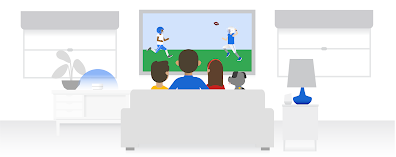This is the second installment in our series Watch This Way, aimed at making watching TV over the Internet easier. If you missed the first one, you can find it here.

The beers are cold, the wings are hot, the guac is fresh — there’s just one thing left to figure out: How are you going to watch that college basketball game, big football spectacular, or tennis match Down Under this weekend on the big, new TV you picked up over the holidays?
First, you don’t need cable. (What? Yes. Really.) In fact, if you’re a cord-cutter — or you have gigabit Internet and prefer a superior watching experience — you can watch most games, matches, and championships in real time over the Internet. Consider this your three-step plan to becoming the ultimate watch party host.
- Choose your cable substitute. Some channels will let you watch for free over the web or their apps, and there are also channels that have their own apps, like ESPN+. Most cable alternatives — like YouTube TV, fuboTV, AT&T TV Now, Sling TV, or Hulu+Live TV — carry local broadcast affiliates, which means you’ll be able to watch games and matches there, too. (Be sure to check listings in advance, so you’re not disappointed.) Got a digital antenna? You can also use that to watch sports broadcast over-the-air for free.
- Pick your device. You can watch on your computer, tablet, or phone, but assuming you’re making a party out of it, you’ll want to connect your TV to the Internet. You can do so by using a streaming device such as a Roku Player, Google Chromecast, Amazon Fire TV, XBox One, Android TV, or Apple TV (Gen 4 or above). And with many smart TVs, you can watch directly by using the app of your choice.
- Decide if you’ll be watching in 4K Ultra HD. Sports are often the first events to take advantage of the biggest, brightest resolution — and yes, that includes live broadcasts, too. When you watch in 4K UHD, you get four times the resolution than you’d get with standard HD, which makes it four times clearer. You just need a 4K TV to take advantage of that superior viewing experience.
Now you’re set to be the ultimate watch party host, no matter the sport … provided your food game is as strong as your TV game. Go [insert your team here]!
Posted by Google Fiber Marketing